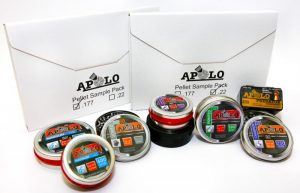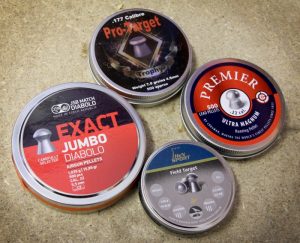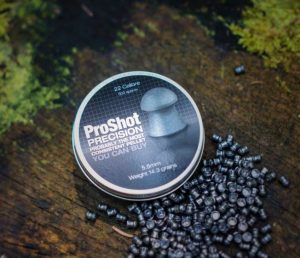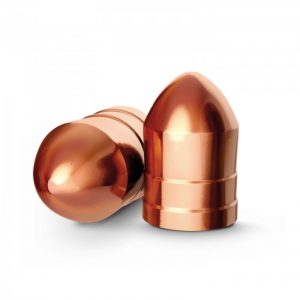So you have your rifle. What’s the first accessory you’re going to need? Well, something to shoot out of it might be an idea; so let’s look at your choice of pellets.

Now, the barrel of any air rifle will contain minute imperfections in both the material and rifling, which can have a large effect over shot placement. What this means is, every airgun will respond differently to pellets and different shooters. For example, I have a TX200 that prefers JSB Exact pellets to anything Air Arms have to offer; so much for brand loyalty.
So a good thing to buy would be a Pellet Sample Pack. This way you can try out a couple of different types of pellet before committing to one, to see not only what your rifle prefers, but what kind is best for what you need.
Everyone has a type
Flathead or Wadcutter :
These pellets are ideal for shooting paper targets, where their flat, circular nose will cut a clean hole through paper, allowing you to see exactly where you’ve hit. This makes them ideal for zeroing in scopes and lasers, as well as for competitions, where competitive scoring must be as accurate as possible.
These pellets do also have some hunting utility, particularly in smaller calibres, as they have a high rate of deformation and expansion upon impact, which leads to larger wound channels and less chance to wound.
Notable Examples : Gamekeeper Rat Dispatcher, Pro-Target Trophy, Apolo Champion.
Hollow Points :
These pellets have an indentation in their nose, which, upon impact, drives air into the centre of the pellet, causing rapid expansion. These pellets are designed for hunting and pest control, and are best used at short to medium range to be most effective. This is because the hollow point in the centre can affect accuracy and cause the pellet to tumble at longer distances.
I would recommend them for anyone thinking of using a pistol for pest control, as the higher level of energy transfer from the pellet can help counteract the pistol’s lower power.
One thing that’s good about hollow points is that, thanks to their high rate of expansion, they’re extremely unlikely to over-penetrate, and, although I would always pay concern to what is behind your target, this will minimise the risk.
Notable Examples :Crosman Piranha Hollowpoint, Bisley Pest Control, H&N Baracuda Hunter Extreme.

Pointed : Designed to prioritise accuracy above all other aspects, pointed pellets are created to maximise aerodynamics around the fired pellet to ensure a laser-straight flight path. That’s the theory anyway. However, from my experience, pointed pellets tend to be amongst the most inconsistent.
After some testing, I’ve concluded that it’s down to the way the pellets are manufactured and stored. The pointed pellet works fantastically well only if the point is aligned correctly, and, due to pellets being stored in a tin without much protection, this is the exception and not the rule.
Having said that, my dismissal of pointed pellets has led me to experiment with them less, but I have a couple of friends who swear by Gamekeeper Infiltrators for rabbits, which I am yet to try. So let’s just say I’m waiting to be won over.
Notable Examples : Gamekeeper Infiltrator, Webley Powapell, Apolo Jumbo.
Domed : The classic pellet shape. Domed pellets are by far the most popular shape of pellet and are really a jack of all trades. Their shape leads them to be accurate, with deep penetration and reliable expansion, without excelling in any of those areas.
Honestly, these pellets can do anything pretty well, and if I didn’t have a specific task in mind, these would be the pellets I’d go for. Since they’re the most common type of pellet, there’s a very long list of pellet brands, all with variations in shape, so something is almost guaranteed to suit your shooting style.
One thing to bear in mind with domed pellets is that, more than any other, they offer differing skirt sizes. Now, the skirt is the size of the end of the pellet and effectively equates to how tight the seal is of the pellet inside the barrel. The tighter the seal, the more pressure has to build up behind the pellet for it to be fired, therefore increasing FPS. This skirt size will be represented by an additional .01 when listing the pellets size. For example, .177 pellets which are usually 4.5mm will be listed as 4.50, 4.51, 4.52 etc.
A wider skirt will leave more lead behind inside the barrel. This lead fouling will need to be regularly cleaned to keep your rifle in perfect working order, as large build up can affect both power and accuracy. Also, some magazines, most notably semi-automatic rifles like the Sig Sauer MCX and Beretta CX4, tend to prefer smaller skirted pellets, so I would stick with .50 or .51 if using these rifles.
Notable Examples : ProShot Precision Magnum, Weihrauch Field Target Special, Air Arms Field, JSB Exact Pellets.
What are you made of?
The next important consideration is the material that the pellet is made from. The various qualities of these materials, such as weight and hardness, will play an important role in how the pellet flies through the air and also how the pellet behaves when it impacts the target.

Lead : The first and by far the most popular choice is lead. Lead has been used for ammunition for literally centuries, thanks to its properties of being not only very heavy for its size, but also a relatively common material.
Its weight makes it a great projectile, as a small lead pellet will transfer more energy into the target than a larger pellet made from a lighter material. This means that the pellet is more effective in smaller calibres, and that it’s also less affected by environmental conditions in flight, such as wind.
Lead was also traditionally chosen because of its relative softness. This leads to deformation upon impact, dramatically widening the wound channel and leading to more effective hunting. Nobody likes wounding animals, so the fact that lead dramatically decreases this risk makes it a great choice for hunters.
Lead is not without its downsides, however, and because of its soft nature, the pellet often leaves a small amount of residue inside the barrel. This is an advantage, as it helps lubricate the barrel, but the build-up will start to affect accuracy and will need to be periodically removed – not a particularly hard job, but something to bear in mind.
Lead is also hazardous to the environment and is particularly toxic when it enters river systems. As a result, many places are becoming stricter on its use in ammunition, particularly the use of lead shot, and this is a trend I can see continuing with people’s growing concern over the environment.
Lead pellets are great for almost any task and are perfect for sub 12ft/lb air rifles, where their rapid expansion ensures humane hunting.
Notable Examples : ProShot Precision Heavy, RWS Super Field, H&N Field Target Trophy.
Copper : The military has been using copper jacketed ammunition for over a century, so copper coated pellets are nothing new in the airgun world. But how do they compare to their lead alternatives?

Well, first of all, they provide a handy barrier between the lead and your hands, which is always good, as lead’s not a particularly nice material to ingest. They are also significantly harder than 100% lead pellets, which has two distinct advantages. Firstly, they offer greater penetration, and pointed copper pellets offer some of the deepest penetration of any airgun ammunition.
The harder coating also provides protection against damage, and means that the pellets in the tin are far more uniform. This increases shot-to-shot consistency, and ensures the pellets are all in excellent condition when fired. It’s certain a strong reason to recommend the use of pointed copper pellets, as the problems that lead pellets have with making a reliable point is not present here.
Copper may be far less toxic to animals than lead, but it’s actually far more dangerous to plants. I always remember being taught the best way to kill a tree stump: hammer it full of copper nails. Now, thanks to their great penetration, copper pellets can perform a similar, if largely unwanted, role; so always ensure a safe backstop.
Copper Pellets, I think, are best used in conjunction with high-powered FAC air rifles, where their harder coating and more uniform shape will yield incredibly high accuracy.
Notable Examples : H&N Baracuda Power, Apolo Air Boss Barracuda Copper, Apolo Hollow Point Copper, ProShot Precision Pacifier
Alloy : PBA or Alloy pellets are a fairly new development when it comes to airgun ammunition and are available in quite a limited number of designs.
Alloy pellets have the advantage of being non-toxic and can be safely handled and fired, although I would always ensure a secure backstop. The pellets themselves are often lighter than lead or copper, and consequently can produce higher feet per second. FPS is not necessarily the most important metric when viewed on its own, but it can aid accuracy and give a boost to range.
Alloy pellets do tend to be expensive, however, and I would only recommend them for close range target shooting in 6ft/lb pistols and 12ft/lb rifles, where they will perform very well. Anything more powerful than that, and you’re going to be getting close to the sound barrier (~1125 FPS depending on temperature), something that most airgun pellets are not designed for, and something that will negatively affect your accuracy. The noise they make, however, will be awesome.
Notable Examples : H&N Baracuda Green, Gamo PBA Platinum, H&N Match Green
In Conclusion
Hopefully that clears up some of the jargon surrounding airgun pellets; it can be quite a confusing topic for the uninitiated. I would recommend buying a decent tin of domed lead pellets as they can do pretty much anything well, and then starting out with a sample pack to determine what is best for individual tasks.

